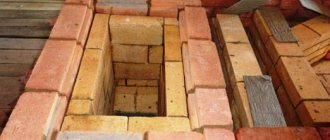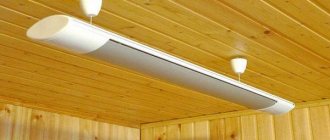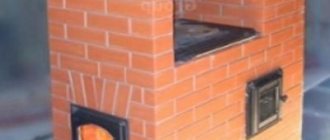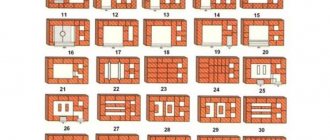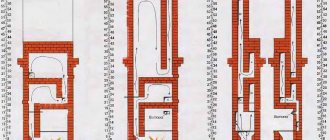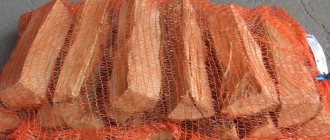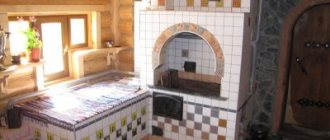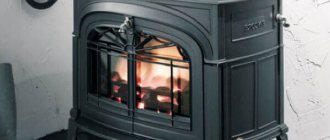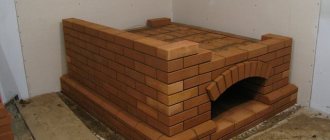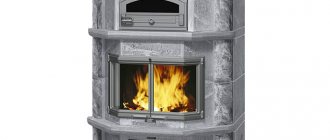In a private home, a stove is used not only for heating rooms, but also for cooking. The design allows you to live comfortably regardless of the possibility of connecting the building to a centralized gas pipeline. However, the installation of a conventional stove with a hob is carried out by specialists. Despite the complexity of the work, it will be useful for the homeowner to know the selection criteria and popular models of brick heating and cooking structures. Let's also consider the "Swedish" order developed by Ryazankin.
Laying a stove with a metal surface for cooking Source pyromasse.ca
Rules for choosing a cooking stove
Creating a brick oven, additionally equipped with a hob, is a long and labor-intensive process that must be carried out evenly and carefully only by experienced specialists. Only professionals will be able to put together a functional structure. Such a device will effectively heat the premises and provide the opportunity to prepare delicious dishes.
There are different designs of brick stoves for houses with order. The designs differ in size, appearance, and internal structure. They are created small and large, focusing on the area of the house. The provisions of SNiP 41-01-2003 are also taken into account. The rules from it must be followed when selecting a place for furnaces and determining the necessary set of works for additional thermal insulation of the building. Otherwise, problems arise with government agencies that control the fire safety of residential buildings.
Modern stove designs are developed using computer programs Source pro2-bar-s3-cdn-cf5.myportfolio.com
Proven stove designs allow you to create efficient heating and cooking structures from bricks. Moreover, each of them will have its own operational characteristics. Therefore, when making a final decision, be sure to pay attention to a number of important points:
- The size of the stove, in which, regardless of design, the front and rear walls will necessarily give off more heat compared to the side surfaces.
- Features of installing a brick structure. For faster and more efficient heating of a specific room, the side wall of the stove should face towards this room. At the same time, its hob must be located in the kitchen space.
- Heat transfer, which is selected taking into account the area of the heated room. Additionally, the location of the room is also taken into account.
On a note! Lighting and heating a large stove requires a lot of solid fuel and time. Therefore, this design is never chosen for heating a small room.
The dimensions of the stove are always chosen according to the dimensions of the room Source build-experts.ru
The efficiency of any brick heating structure depends on the thermal insulation of the house. If the insulation of the building is done efficiently, then a small stove will be enough to heat it. After all, reliably thermally insulated building structures will retain heat well in the building. At the same time, high-quality insulation is an insurmountable barrier to the cold outside.
The main advantages of the Swedish
What is most attractive about the design of the Swedish stove is the efficiency of fuel combustion.
Thanks to a successful technical design, coal, firewood, reeds or small wood burns in the firebox, forming a large mass of thermal energy.
Unlike a traditional Russian stove, which takes a lot of time before it starts giving off heat, a Swedish stove heats up very quickly. Thanks to this, within 10-15 minutes after laying and lighting firewood, the room is filled with warmth.
Swedish: advantages
At the same time, it not only quickly warms up the room, but also retains heat. To do this, after the firewood has died down, it is necessary to close the valve tightly. Otherwise, all the heat that has accumulated in the oven will quickly come out.
Like the popular Dutch oven, the Swede is very compact and does not take up much space in the house, which is indispensable in small country houses where the location of a large Russian stove simply does not make sense.
In addition, the cooking hob and oven provide additional comfort and increase the functionality of the oven.
Advantages of a Swedish woman:
- compact dimensions;
- functionality (hob, oven, water heating, etc.);
- fuel efficiency;
- the ability to warm two rooms at the same time.
But, speaking about the advantages of the Swede, it would be unfair not to notice some of her shortcomings.
The design of the Swedish stove is very demanding in terms of the choice of material. If ordinary fireclay brick is suitable for creating a Russian stove, then you need to stock up on very high-quality materials, otherwise the efficiency of the heating apparatus will be greatly reduced.
In addition, the design of such a furnace is quite complex and requires certain knowledge and a very subtle, scrupulous approach. After installation and launch, it will be very difficult to eliminate your mistakes.
Stove models
When existing brick stove designs are considered, attention is paid to the features of each design. After all, you can fold the device with a complex or simpler internal configuration of smoke exhaust channels. The final decision is always made on an individual basis. That is why it is recommended to contact specialists in order to avoid mistakes at the initial stage.
A brick heating and cooking stove can be manufactured in the following options:
- T-shaped and have a massive structure.
This stove is often placed in the middle of a large room. This arrangement allows you to divide the room into separate zones. In addition, a T-shaped stove can be placed between two or even three rooms. This location option will allow you to effectively heat 2 or 3 rooms at once.
T-shaped brick heating stove Source remontnik.ru
On a note! The T-shaped model is an ideal option for a medium-sized private residential building.
- A narrow design in which the hob protrudes from one side.
These types of stoves take up less space in the premises. At the same time, they have a simple design and are installed to heat a maximum of two rooms.
A brick stove in which the hob protrudes from the left side Source iz-kirpicha.su
On a note! Narrow stoves with a protruding part are often heated with dry branches, created in country houses and placed between the kitchen and living room.
- Heated protruding bed, aesthetic appearance and medium size.
Such brick stoves for a home with a hob are smaller than full-fledged Russian heating structures. At the same time, they provide owners with the opportunity to use a large number of functions. Usually in these stoves the hob is located in a built-in chamber. It is convenient to prepare a variety of dishes here.
Some models have an additional built-in camera. It will allow you to bake homemade bread. There are also options with an upper chamber, intended, for example, for heating dishes or drying vegetables.
Stoves with a stove bench and hob are equipped with doors that are entirely made of cast iron or have glass filling. The size of this element can be large, which will allow the structure to be used even as a fireplace. At the same time, any family member will always be able to relax in a warm bed, since the design of such stoves includes a bed, under which there are channels for flue gases.
Brick stove with heated stove bench Source pechiexpert.ru
- Open or closed fireplace fireplace.
This brick heating and cooking stove can be placed in the middle of a residential building. With this arrangement, the fireplace will be located, for example, in the bedroom or living room, and the hob will be in the kitchen. If the stove is placed in the middle of the house, then the entire floor will be filled with heat from the structure. Even the rooms located behind the rear stove wall will be heated.
Modern versions of stoves are most often designs that are simultaneously equipped with a “summer” operation and the ability to work exclusively in warm weather. This device will allow you to save fuel by using only the stove in the summer. At the same time, in warm weather the entire structure will not heat up completely. Therefore, the premises will have a comfortable atmosphere. After all, people in the rooms of the house will not have to endure the heat of the stove in the summer.
Original stove with fireplace insert and hob Source dompech.ru
Popular models of multifunctional ovens
Some models equipped with a hob have a rather complex device. And the difficulty lies not in adding an additional option, but in constructing a chimney duct. You should immediately evaluate your capabilities and choose the project in which the route for removing combustion products will be the simplest.
The stoves with which many craftsmen began their careers are known among consumers under the names “Swedish” and “Dutch”. Their order is simplified as much as possible, and functionality is at the proper level. In addition, there are known developments named after their creators. For example, Bykov's stove, Porfiryev's stove. All of them are made of brick and differ in the configuration of the main elements, their relative position and the route of the chimney channels.
- A T-shaped stove is usually used as an island option. It is located in the center of the room, dividing the space into zones and heating them at the same time. This model is quite large, so it is used over large areas. Naturally, the large volume of the oven can accommodate several devices, including those for cooking.
T-shaped design
- For a small house or cottage, a narrow stove has been developed, which has a protruding cooking surface. This model is not equipped with an oven, but it is compact in size and has excellent technical characteristics.
Narrow version
- The traditions of Russian craftsmen were not lost in history, but were passed on to us through generations. Of course, modern stoves only vaguely resemble the Russian stove from folk tales, but they have retained all the necessary functions. Such options are complemented by a heated bench, oven or roasting pan in which you can bake pies. The oven body has various niches for drying clothes. In such a complex you can prepare several different dishes at the same time.
Classic building
Swedish order
Before you correctly assemble the stove and the brick stove itself, you need to thoroughly understand the order of the entire heating and cooking structure being created. At the same time, the Swedish fireplace stove is popular among homeowners and stove makers in Russia. Its design was developed by A. Ryazankin.
One of the variants of the “Swedish” stove heating design Source 2stiralki.ru
See also: Catalog of companies that specialize in the design and installation of fireplaces and stoves
The Swedish fireplace stove, designed by Ryazankin, has a simple layout. This compact heating and cooking design heats up quickly and features an oven. In addition, the design of the stove allows it to function like a fireplace. This option is great for heating 2 rooms. Although in fact there are a huge number of modifications of the Swedes.
Most professionals are familiar with the Ryazankin stove design. Therefore, they will always help and tell you how to lay a brick stove in a country house step by step for beginners. The order itself looks like this:
- The base of the furnace structure is the first row of bricks made of 34 elements.
It is created on a pre-prepared foundation, which is pre-coated with 2 layers of roofing felt or other similar waterproofing.
For any of the options in the Swedish stove, the 1st row consists of brick blocks tightly laid together Source 1-teplodom.ru
The use of a large amount of brick implies its dense installation. In other words, a specialist creates a kind of slab from it, in which there will be no smoke exhaust holes or any chambers. This so-called stove base will increase the reliability of the entire structure. However, it is laid out exactly along the horizon within the previously designated angles on the waterproofing.
On a note! A specialist first carries out dry, step-by-step laying of a brick stove for a home. Only after this does a professional use a mortar to fix the bricks.
- For the subsequent, second row, use 30.5 bricks.
They are also placed close to each other. In other words, they create a continuous plane. Where the fireplace will be, the craftsman attaches metal brackets. They are usually made from reinforcement. They are necessary so that in the future it will be possible to secure the fireplace grate by welding.
One of the options for a fireplace grate attached to pre-installed brackets Source kuznia-diadi-vani.narod.ru
On a note! If a specialist uses a grid with brackets in his work, then he fixes it on the masonry while creating the second row.
- To lay the third row you need 19 bricks.
They begin to create combustion walls and channels for the movement of combustion products. At the same time, do not forget to leave openings where doors will later be installed to ventilate and clean the interior of the stove.
On a note! The master always provides a minimum of 17 cm between the oven and the smoke channel, which will be formed in the vertical direction.
The cleaning and venting doors are also installed at this stage of work. They are attached using wire by twisting it. In this case, such fasteners are embedded between brick rows.
Cleaning and blowing chamber (position 2 and 3) in the furnace masonry, where the corresponding doors are subsequently installed Source ahbanya.ru
- Laying the fourth row when installing a stove is carried out using 18 bricks.
With their help, all cleaning and blower doors are thoroughly secured. In this case, the seams between the rows may turn out wider, because there is still wire here.
- For the next, fifth row, use 24 brick blocks.
When a specialist places them above the blower chamber, then he first makes grooves in them. They are needed to secure the grate. At the same time, the master prepares a place for the oven. It is usually a metal box. To mount it, the height of the front bricks must be 2.5 cm.
Important! The installation of a stove in a private house made of brick with a stove is carried out using heat-resistant fireclay blocks. They are used for laying out firebox walls.
Kiln fireclay bricks Source taldom.favoright.ru
On a note! The oven metal box is installed in its place only after it is lined with asbestos. The material creates a gap that will allow the material to expand when heated and maintain its integrity.
General recommendations for choosing building materials
You should only take on the construction of a Swedish stove with your own hands if you already have at least some initial masonry experience. This is a rather complex design and should not be chosen as the first experiment.
If you have basic bricklaying skills and have already dealt with installing stoves, then our detailed step-by-step instructions will allow you to master this process. Follow the instructions exactly and build each row in accordance with the indicated diagram.
Do-it-yourself Swedish oven
As mentioned above, the Swedish oven requires a very careful and careful approach. Unlike a traditional Russian or Dutch oven, used brick is not suitable for it. The efficiency and productivity of the Swede directly depends on the quality of the material. It is better to take fireclay or red brick.
Important! It is unacceptable to use silicate or hollow bricks to build a furnace.
You should also pay attention to the choice of solution. To build a firebox, it is necessary to mix a solution of special fireclay clay, which can withstand high temperatures. The clay should be smooth and of medium fat content.
To check whether the kneading is done correctly, take a thin layer of clay and apply it to a vertical surface. It should not drain and the consistency should resemble thick sour cream. Under no circumstances should there be any lumps or unmixed solution in the mixture.
Ordinary clay is suitable for lining a heating structure. If you make a fuel ignition chamber out of it, it will crack and the integrity of the stove may be at risk.
Fireclay brick
Separately, it should be said about the foundation for a Swedish stove. Given its heavy weight, the base must be made strong. It takes at least three weeks for the concrete monolith to harden. If you hurry and start laying on a fresh, not completely hardened foundation, then the heavy weight may cause the stove to become deformed.
One of the weak points of the Swede is the fire door. If you take a budget door from a stamped sheet, it will quickly become loose and fail. Therefore, it is necessary to take a cast door with a mustache, which will need to be securely walled up during laying.
You can vary the size of the stove and oven within 5-10 cm, but the thickness of the oven is of great importance. If you cook the oven yourself, use steel, which does not conduct heat well. If you take thin roofing iron, then such an oven will cool down quickly.
Video description
You can clearly see one of the options for arranging a Swedish stove without a fireplace compartment in the following video:
- The next, tenth row is created with bricks in the amount of 17.5 pieces.
They cover the front part of the place where the oven will be. The blocks are mounted directly on metal strips. Their installation allows you to combine the space above the firebox and oven. In this case, cutouts are first made at the top of the bricks used. They will allow you to subsequently lay the cast iron hob.
On a note! At the same stage, a place is designed where in the future a small door will be installed, allowing the upper part of the fireplace chamber to be cleaned.
- For the next, eleventh row, use 18.5 bricks.
From these they begin to build the walls of the brewing compartment, where there is already a cast iron panel. The brick blocks laid on the right should close the gap between the fixed cooking plate and the already created wall. At the same time, the blocks that are used to create the back wall of the fireplace chamber are pushed forward 4 cm and then pulled together. This allows you to continue creating the inclined surface.
Video description
Another option for creating a stove is shown in the video:
- Further, in the twelfth row, exactly 18 bricks are used.
With their help, the door of the cleaning compartment is closed and the formation of the rear wall of the fireplace chamber continues.
- At the next stage - for the thirteenth row, 19 bricks are used.
When using blocks in a fireplace compartment, they are pulled out and cut away. The same row allows you to raise the walls of the open hob.
- Also 19 bricks are used in the next, twentieth row.
They begin to form a shelf above the fireplace insert. To do this, each brick is pushed 3 cm not only forward, but also to the side. The result is an overhanging row over the firebox.
- Further, in the twenty-first row, 20.5 bricks are used.
With their help, the walls of the cooking compartment are completed and the construction of the fireplace mantel continues.
- Then, in the twenty-second row, 15.5 bricks are laid.
They are reinforced with a steel angle above the cooking chamber. Metal strips are also used above this compartment. They are installed in the middle and rear part, the so-called ceiling of the cooking chamber. The elements are needed to subsequently cover the entire tier.
Briefly about the main thing
A brick heating and cooking stove, installed by professionals, may additionally have a fireplace section, a heated bench, a chamber for drying vegetables and other useful compartments. Today, many projects of such structures for private houses have been created. Moreover, they have a T-shape, wide or narrow design.
The stove is selected depending on the area of the room and the entire residential building. Its location is also taken into account. After all, it can be located at the corner, in the middle or against the wall of the room.
One of the interesting options is the Swedish stove-fireplace, designed by Ryazankin. This is a small but functional design. During the laying of each row, from 5 to 36 bricks are used.
Basic design of stoves with an oven
A detailed guide to self-laying gives a complete description of the steps, down to the location of each brick. But for better quality work, each master must be theoretically aware of the purpose of the main elements of the furnace. In simple words, he must understand what he is doing. For this purpose, there are schematic diagrams or descriptions of the device.
Good to know: Tiled stoves-fireplaces, a new wave of popularity of antique finishes
A fireplace stove with an oven is a combination of two devices in a single design.
- A fireplace differs from a stove in that its purpose focuses on the hearth, its appearance, visibility and ease of use. Heating qualities are given secondary attention. Hence the more primitive structure of the fireplace chimney.
- The purpose of the stove is to heat a room or an entire house. All technical features are aimed at converting the energy released during the combustion of solid fuel into useful heat as efficiently as possible. To do this, it is necessary to use certain materials, select the optimal dimensions of the firebox and chimney, arrange a chimney channel with the largest area, and provide the necessary draft for air circulation. All these tasks are implemented in the design of the furnace.
The idea of combining a fireplace with a stove is not new. It is successfully used in many proven models. The structure of the fireplace hearth differs from the firebox, but can be adapted, since the stove firebox is only supplemented with a grate.
Ready-to-use furnace system
The operation of the oven is ensured by the niche being surrounded by channels through which hot air passes. But in some designs, the temperature inside the oven increases from the immediate proximity to the firebox in which combustion occurs.
The design of the furnace can be considered in individual points:
- The firebox is made in the form of a chamber lined with fireclay bricks. If the design includes a hob, the fire chamber is zoned by a partition. Firstly, the top part of the flame has the highest temperature. Secondly, firewood or other fuel should not interfere with dishes placed on the stove with open views. Therefore, combustion occurs in one zone, and the flame, due to draft, is drawn into the second zone where the stove is located.
- There is an ash pan at the bottom of the stove, under the firebox. Its door acts as a blower. The draft directly depends on the amount of incoming air, so using the blower you can regulate the intensity of combustion. In stoves intended for heating, the fireboxes are usually closed. They are known to increase the efficiency of the device. But the function of the fireplace requires visibility, so the firebox door is made of transparent glass, resistant to high temperatures.
- The chimney, due to its complex structure, has several cleaning doors that allow the channel to be serviced in sections.
Good to know: How to make a stove for burning waste in a country house, ready-made options
